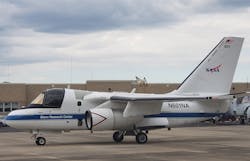Collins and NASA work to advance tech for safe operation of UAS in National Airspace System
CEDAR RAPIDS, Iowa - Collins Aerospace Systems is entering the final stages of a nine-year project with NASA to enable unmanned aircraft systems (UAS) to operate safely in the National Airspace System (NAS). The project, co-funded by Collins Aerospace and which is expected to be completed in Sept. 2020, has facilitated the development of a Command Non-Payload Control (CNPC) data link waveform that informed the initial certification standards for UAS Command and Control in the NAS.
Collins Aerospace invested in a series of prototype radios to house the waveform for NASA's flight tests. A C-Band prototype CNPC data link radio, called the CNPC-5000, was the baseline for the most recent testing and will continue to be a key component in future research and test flights for other programs.
"CNPC is critical to maintaining positive control of UAS in complex operations within national airspace, such as flights beyond visual line of sight or above 500 feet. We've already applied our CNPC waveform to the FAA's Pathfinder program with BNSF Railway," said Heather Robertson, vice president and general manager, Integrated Solutions for Collins Aerospace. "Our CNPC-5000 data links provide the reliable, safe and secure connection needed to maintain control of unmanned aircraft at all times while operating in the complex environment of controlled airspace."
The prototype CNPC-5000 radio will be supporting NASA's System Integration Operationalization (SIO) program through flights with General Atomics' SkyGuardian. Multiple CNPC-5000 demonstrations are also planned throughout 2020. Along with the CNPC-5000, Collins Aerospace continues to invest in other critical technologies that will facilitate the integration of UAS into the NAS.
This year, the company announced its involvement in the first successful end-to-end flight of General Atomics' SkyGuardian in civil airspace with its Pro Line Fusion integrated avionics system as part of a Certifiable Ground Control Station. The company's web-based WebUAS operations management tool has also been used in various test flights and programs to coordinate the multi-node CNPC network, provide real-time situational awareness to flight safety critical information such as link quality, and act as a gateway to weather, air traffic and critical information and services.
